Exploring the Impact of Climate Change on Arctic Shipping through the Lenses of Quadruple Bottom Line and Sustainable Development Goals
Abstract
:1. Introduction
2. Context, Methodology, and Contribution
3. A QBL and SDG Approach to ArSh
3.1. Implications for Economic Sustainability
3.2. Implications for Environmental Sustainability
3.3. Implications for Social Sustainability
3.4. Implications for Cultural Sustainability
3.5. A Recap of QBL Analysis
4. Discussion and Implications
5. Conclusions and Future Research
Author Contributions
Funding
Data Availability Statement
Conflicts of Interest
References
- Copland, L.; Dawson, J.; Johnston, M.E.; Pizzolato, L.; Howell, S.E.; Pelot, R.; Etienne, L.; Matthews, L.; Parsons, J. Climate Change Adaptation Strategies and Policy Options for Arctic Shipping. A Report Prepared for Transport Canada; Geography, Environment and Geomatics—Publications: Ottawa, ON, Canada, 2017; Available online: https://www.arcticcorridors.ca/wp-content/uploads/2020/07/Climate-Change-Adaptation-Strategies-sm.pdf (accessed on 3 May 2021).
- Overland, J.; Wang, M. When will the summer Arctic be nearly sea ice free? Geophys. Res. Lett. 2013, 40, 2097–2101. [Google Scholar] [CrossRef]
- Dawson, J.; Copland, L.; Mussells, O.; Carter, N. Shipping Trends in Nunavut 1990–2015: A Report Prepared for the Nunavut General Monitoring Program. Ottawa, Canada and Iqaluit, Nunavut. 2017. Available online: https://www.arcticcorridors.ca/wp-content/uploads/2019/12/NGMP-Shipping-Report_APR2018_WEB.pdf (accessed on 10 June 2021).
- Dawson, J.; Carter, N.; van Luijk, N.; Parker, C.; Weber, M.; Cook, A.; Grey, K.; Provencher, J. Infusing Inuit and local knowledge into the Low Impact Shipping Corridors: An adaptation to increased shipping activity and climate change in Arctic Canada. Environ. Sci. Policy 2020, 105, 19–36. [Google Scholar] [CrossRef]
- Marsh Risk Management Research. Arctic Shipping: Navigating the Risks and Opportunities. 2014. Available online: https://www.safety4sea.com/wp-content/uploads/2014/09/pdf/Arctic_Shipping_Lanes_MRMR_August_2014_US.pdf (accessed on 10 May 2021).
- Lu, D.; Park, G.; Choi, K.; Oh, S. An economic analysis of container shipping through Canadian Northwest Passage. Int. J. e-Navig. Marit. Econ. 2014, 1, 60–72. [Google Scholar] [CrossRef] [Green Version]
- DeRepentigny, P.; Jahn, A.; Holland, M.M.; Smith, A. Arctic Sea Ice in Two Configurations of the CESM2 During the 20th and 21st Centuries. J. Geophys. Res. Oceans 2020, 125, e2020JC016133. [Google Scholar] [CrossRef]
- King, H. What Is the Northwest Passage? Climate Change Has Opened a Shipping Route through the Canadian Arctic. Geology News and Information. 2021. Available online: https://geology.com/articles/northwest-passage.shtml (accessed on 15 March 2021).
- Powell, N. Northern Exposure: Can the Northwest Passage Live up to Its Billing as a Maritime Superhighway? Financial Post. 2018. Available online: https://financialpost.com/news/economy/northern-exposure-can-the-northwest-passage-live-up-to-its-billing-as-a-maritime-superhighway (accessed on 17 March 2021).
- Cheaitou, A.; Faury, O.; Cariou, P.; Hamdan, S.; Fabbri, G. Economic and environmental impacts of Arctic shipping: A probabilistic approach. Transp. Res. Part D Transp. Environ. 2020, 89, 102606. [Google Scholar] [CrossRef]
- Ülkü, M.A.; Engau, A. Sustainable Supply Chain Analytics. In Industry, Innovation and Infrastructure; Leal Filho, W., Azul, A.M., Brandli, L., Lange Salvia, A., Wall, T., Eds.; Encyclopedia of the UN Sustainable Development Goals; Springer: Cham, Switzerland, 2021; pp. 1123–1134. [Google Scholar] [CrossRef]
- Lavissière, A.; Sohier, R.; Lavissière, M.C. Transportation systems in the Arctic: A systematic literature review using textometry. Transp. Res. Part A Policy Pract. 2020, 141, 130–146. [Google Scholar] [CrossRef]
- Corbett, J.J.; Lack, D.A.; Winebrake, J.J.; Harder, S.; Silberman, J.A.; Gold, M. Arctic shipping emissions inventories and future scenarios. Atmos. Chem. Phys. 2010, 10, 9689–9704. [Google Scholar] [CrossRef] [Green Version]
- Smith, L.C.; Stephenson, S.R. New trans-Arctic shipping routes navigable by midcentury. Proc. Natl. Acad. Sci. USA 2013, 110, E1191–E1195. [Google Scholar] [CrossRef] [Green Version]
- Buixadé Farré, A.; Stephenson, S.R.; Chen, L.; Czub, M.; Dai, Y.; Demchev, D.; Efimov, Y.; Graczyk, P.; Grythe, H.; Keil, K.; et al. Commercial Arctic shipping through the Northeast Passage: Routes, resources, governance, technology, and infrastructure. Polar Geogr. 2014, 37, 298–324. [Google Scholar] [CrossRef]
- Miller, W.; Ruiz, G. Arctic shipping and marine invaders. Nat. Clim. Chang. 2014, 4, 413–416. [Google Scholar] [CrossRef]
- Ghosh, S.; Rubly, C. The emergence of Arctic shipping: Issues, threats, costs, and risk- mitigating strategies of the Polar Code. Aust. J. Marit. Ocean Aff. 2015, 7, 171–182. [Google Scholar] [CrossRef]
- Champalle, C.; Ford, J.D.; Sherman, M. Prioritizing Climate Change Adaptations in Canadian Arctic Communities. Sustainability 2015, 7, 9268–9292. [Google Scholar] [CrossRef] [Green Version]
- Halliday, W.; Insley, S.J.; Hilliard, R.C.; de Jong, T.; Pine, M.K. Potential impacts of shipping noise on marine mammals in the western Canadian Arctic. Mar. Pollut. Bull. 2017, 123, 73–82. [Google Scholar] [CrossRef] [PubMed]
- Theocharis, D.; Pettit, S.; Rodrigues, V.S.; Haider, J. Arctic shipping: A systematic literature review of comparative studies. J. Transp. Geogr. 2018, 69, 112–128. [Google Scholar] [CrossRef]
- Ng, A.K.; Andrews, J.; Babb, D.; Lin, Y.; Becker, A. Implications of climate change for shipping: Opening the Arctic seas. Wiley Interdiscip. Rev. Clim. Change 2018, 9, e507. [Google Scholar] [CrossRef]
- Downing, J. An Evaluation of the Impact of Shipping on Arctic Indigenous Peoples. The Henry M. Jackson School of International Studies. 2019. Available online: https://jsis.washington.edu/news/an-evaluation-of-the-impact-of-shipping-on-arctic-indigenous-peoples/ (accessed on 17 March 2021).
- Rockström, J.; Steffen, W.; Noone, K.; Persson, Å.; Chapin, E., III; Lambin, E.; Foley, J. Planetary boundaries: Exploring the safe operating space for humanity. Ecol. Soc. 2009, 14, 32. Available online: https://www.ecologyandsociety.org/vol14/iss2/art32/ (accessed on 20 May 2021). [CrossRef]
- Merriam-Webster. Dictionary Entry for “Culture”. 2021. Available online: https://www.merriam-webster.com/dictionary/culture (accessed on 15 February 2021).
- United Nations. The 17 Goals. Department of Economic and Social Affairs. 2021. Available online: https://sdgs.un.org/goals (accessed on 20 March 2021).
- Pradhan, P.; Costa, L.; Rybski, D.; Lucht, W.; Kropp, J.P. A systematic study of sustainable development goal (SDG) interactions. Earth’s Future 2017, 5, 1169–1179. [Google Scholar] [CrossRef] [Green Version]
- Van Zanten, J.A.; van Tulder, R. Improving companies’ impacts on sustainable development: A nexus approach to the SDGS. Bus. Strat. Environ. 2021, 30, 3703–3720. [Google Scholar] [CrossRef]
- Scrimgeour, F.; Iremonger, C. Maori Sustainable Economic Development in New Zealand: Indigenous Practices for the Quadruple Bottom Line; University of Waikato: Hamilton, New Zealand, 2004. [Google Scholar]
- Walters, F.; Takamura, J. The decolonized quadruple bottom line: A framework for developing indigenous innovation. Wicazo Rev. 2015, 30, 77–99. [Google Scholar] [CrossRef]
- Pizzirani, S.; McLaren, S.J.; Forster, M.E.; Pohatu, P.; Porou, T.T.W.; Warmenhoven, T.A. The distinctive recognition of culture within LCSA: Realising the quadruple bottom line. Int. J. Life Cycle Assess. 2018, 23, 663–682. [Google Scholar] [CrossRef]
- Budsaratragoon, P.; Jitmaneeroj, B. Measuring causal relations and identifying critical drivers for corporate sustainability: The quadruple bottom line approach. Meas. Bus. Excel. 2019, 23, 292–316. [Google Scholar] [CrossRef]
- Webster, J.; Watson, R.T. Analyzing the past to prepare for the future: Writing a literature review. MIS Q. 2002, 26, xiii–xxiii. [Google Scholar]
- Snyder, H. Literature review as a research methodology: An overview and guidelines. J. Bus. Res. 2019, 104, 333–339. [Google Scholar] [CrossRef]
- Dawson, J. Arctic shipping: Future prospects and ocean governance. In The Future of Ocean Governance and Capacity Development; International Ocean Institute-Canada, Ed.; e-book, Brill|Nijhoff: Leiden, The Netherlands, 2018; pp. 484–489. [Google Scholar] [CrossRef] [Green Version]
- Pizzi, S.; Rosati, F.; Venturelli, A. The determinants of business contribution to the 2030 agenda: Introducing the SDG reporting score. Bus. Strategy Environ. 2021, 30, 404–421. [Google Scholar] [CrossRef]
- Ceballos, G.; Ehrlich, P.R.; Dirzo, R. Biological annihilation via the ongoing sixth mass extinction signaled by vertebrate population losses and declines. Proc. Natl. Acad. Sci. USA 2017, 114, E6089–E6096. [Google Scholar] [CrossRef] [PubMed] [Green Version]
- Carter, N.A.; Dawson, J.; Knopp, J.; Joyce, J.; Weber, M.; Kochanowicz, Z.; Mussells, O. Arctic Corridors and Northern Voices: Governing Marine Transportation in the Canadian Arctic (Cambridge Bay, Nunavut Community Report); University of Ottawa: Ottawa, ON, Canada, 2018; Available online: https://ruor.uottawa.ca/handle/10393/37325 (accessed on 1 January 2022).
- Government of Canada. Implications for Economic Development and Adaptation within Key Sectors. Available online: https://www.nrcan.gc.ca/changements-climatiques/impacts-adaptation/implications-economic-development-and-adaptation-within-key-sectors/10273 (accessed on 30 November 2015).
- Weather Atlas. Arctic Bay, Canada—Detailed Climate Information and Monthly Weather Forecast. 2021. Available online: https://www.weather-atlas.com/en/canada/arctic-bay-climate (accessed on 28 March 2021).
- Herrmann, T. Shipping through the Northwest Passage: A Policy Brief. 2019. Available online: https://jsis.washington.edu/news/shipping-through-the-northwest-passage-a-policy-brief/ (accessed on 15 March 2021).
- Huebert, R. Climate Change and Canadian Sovereignty in the Northwest Passage. 2001. Available online: https://journalhosting.ucalgary.ca/index.php/cpmss/article/view/36337 (accessed on 1 April 2021).
- Transport Canada. List of Canada Port Authorities. Government of Canada. 2020. Available online: https://tc.canada.ca/en/marine-transportation/ports-harbours-anchorages/list-canada-port-authorities (accessed on 10 April 2021).
- Government of Canada. Debate and Direction of Arctic Shipping Policy. Transport Canada. 2010. Available online: https://tc.canada.ca/en/marine-transportation/arctic-shipping/debate-direction-arctic-shipping-policy (accessed on 15 May 2021).
- Mills, R. Canada’s Warming Arctic—Implications. Education Canada. 2020. Available online: https://www.mining.com/web/canadas-warming-arctic-implications/ (accessed on 6 March 2021).
- Fedi, L.; Etienne, L.; Faury, O.; Rigot-Muller, P.; Stephenson, S.; Cheaitou, A. Arctic navigation: Stakes, benefits and limits of the POLARIS system. J. Ocean Technol. 2018, 13, 54–67. [Google Scholar]
- Hjelle, H.M.; Fridell, E. When is short sea shipping environmentally competitive? In Environmental Health–Emerging Issues and Practice; Oosthuizen, J., Ed.; InTechOpen: Rijeka, Croatia, 2012; pp. 3–20. [Google Scholar]
- Zeng, Q.; Lu, T.; Lin, K.-C.; Yuen, K.F.; Li, K.X. The competitiveness of Arctic shipping over Suez Canal and China-Europe railway. Transp. Policy 2020, 86, 34–43. [Google Scholar] [CrossRef]
- Weregeland, T. Arctic Shipping Routes—Cost Comparisons with Suez. Arctic Knowledge Hub. 2010. Available online: http://www.arctis-search.com/Arctic+Shipping+Routes+-+Cost+Comparisons+with+Suez (accessed on 11 March 2021).
- IQAir. Air Quality in the World. 2021. Available online: https://www.iqair.com/world-air-quality (accessed on 10 April 2021).
- Van Luijk, N.; Dawson, J.; Cook, A. Analysis of heavy fuel oil use by ships operating in Canadian Arctic waters from 2010 to 2018. FACETS 2020, 5, 304–327. [Google Scholar] [CrossRef]
- Granier, C.; Niemeier, U.; Jungclaus, J.H.; Emmons, L.; Hess, P.; Lamarque, J.-F.; Walters, S.; Brasseur, G.P. Ozone pollution from future ship traffic in the Arctic northern passages. Geophys. Res. Lett. 2006, 33, L13807. [Google Scholar] [CrossRef] [Green Version]
- Schröder, C.; Reimer, N.; Jochmann, P. Environmental impact of exhaust emissions by Arctic shipping. Ambio 2017, 46, 400–409. [Google Scholar] [CrossRef] [Green Version]
- Gong, W.; Beagley, S.R.; Cousineau, S.; Sassi, M.; Munoz-Alpizar, R.; Ménard, S.; Racine, J.; Zhang, J.; Chen, J.; Morrison, H.; et al. Assessing the impact of shipping emissions on air pollution in the Canadian Arctic and northern regions: Current and future modelled scenarios. Atmos. Chem. Phys. 2018, 18, 16653–16687. [Google Scholar] [CrossRef] [Green Version]
- Government of Canada. Canada’s Arctic and Northern Policy Framework. Crown-Indigenous Relations and Northern Affairs Canada. 2019. Available online: https://www.rcaanc-cirnac.gc.ca/eng/1560523306861/1560523330587 (accessed on 3 May 2021).
- United States–Canada Joint Arctic Leaders Statement. 2016. Available online: pm.gc.ca/en/news/statements/2016/12/20/united-states-canada-joint-arctic-leaders-statement (accessed on 10 April 2021).
- Hauser, D.; Stern, H.; Laidre, K. As Arctic Ship Traffic Increases, Narwhals and Other Unique Animals Are at Risk. 2018. Available online: https://theconversation.com/as-arctic-ship-traffic-increases-narwhals-and-other-unique-animals-are-at-risk-99733 (accessed on 20 December 2021).
- NOAA-National Oceanic and Atmospheric Administration. Damage Assessment, Remediation, and Restoration Program—Exxon Valdez. 2020. Available online: https://darrp.noaa.gov/oil-spills/exxon-valdez (accessed on 10 December 2021).
- Eger, K.M. Effects of Oil Spills in Arctic Waters. 2010. Available online: http://www.arctis-search.com/Effects+of+Oil+Spills+in+Arctic+Waters (accessed on 11 March 2021).
- Gautier, D.L.; Bird, K.J.; Charpentier, R.R.; Grantz, A.; Houseknecht, D.W.; Klett, T.R.; Moore, T.E.; Pitman, J.K.; Schenk, C.J.; Schuenemeyer, J.H.; et al. Assessment of Undiscovered Oil and Gas in the Arctic. Science 2009, 324, 1175–1179. [Google Scholar] [CrossRef] [PubMed] [Green Version]
- McDonald, M.A.; Hildebrand, J.A.; Wiggins, S.M. Increases in deep ocean ambient noise in the Northeast Pacific west of San Nicolas Island, California. J. Acoust. Soc. Am. 2006, 120, 711–718. [Google Scholar] [CrossRef] [PubMed] [Green Version]
- NOAA-National Oceanic and Atmospheric Administration. Takes of Marine Mammals Incidental to Specified Activities, Taking Marine Mammals Incidental to Site Characterization Surveys off the Coast of Massachusetts. 2016. Available online: https://www.federalregister.gov/documents/2016/04/05/2016-07712/takes-of-marine-mammals-incidental-to-specified-activities-taking-marine-mammals-incidental-to-site (accessed on 15 March 2021).
- Rolland, R.M.; Parks, S.E.; Hunt, K.E.; Castellote, M.; Corkeron, P.J.; Nowacek, D.P.; Kraus, S.D. Evidence that ship noise increases stress in right whales. Proc. R. Soc. B Biol. Sci. 2012, 279, 2363–2368. [Google Scholar] [CrossRef] [PubMed]
- AMSA. Arctic Marine Shipping Assessment by Arctic Council, Second Printing. 2009. Available online: https://oaarchive.arctic-council.org/handle/11374/54 (accessed on 20 June 2021).
- Government of Canada. Government of Canada Continues to Help Protect North Atlantic Right Whales. 2021. Available online: https://www.canada.ca/en/fisheries-oceans/news/2021/11/government-of-canada-continues-to-help-protect-north-atlantic-right-whales.html (accessed on 30 January 2022).
- Conn, P.B.; Silber, G.K. Vessel speed restrictions reduce risk of collision-related mortality for North Atlantic right whales. Ecosphere 2013, 4, 1–16. [Google Scholar] [CrossRef]
- Hauser, D.D.W.; Laidre, K.L.; Stern, H.L. Vulnerability of Arctic marine mammals to vessel traffic in the increasingly ice-free Northwest Passage and Northern Sea Route. Proc. Natl. Acad. Sci. USA 2018, 115, 7617–7622. [Google Scholar] [CrossRef] [Green Version]
- Higdon, J.W.; Ferguson, S.H. Loss of Arctic sea ice causing punctuated change in sightings of killer whales (Oricinus orca) over the past century. Ecol. Appl. 2009, 19, 1365–1375. [Google Scholar] [CrossRef] [Green Version]
- Goldsmit, J.; Archambault, P.; Chust, G.; Villarino, E.; Liu, G.; Lukovich, J.V.; Barber, D.G.; Howland, K.L. Projecting present and future habitat suitability of ship-mediated aquatic invasive species in the Canadian Arctic. Biol. Invasions 2018, 20, 501–517. [Google Scholar] [CrossRef]
- Chan, F.T.; Stanislawczyk, K.; Sneekes, A.C.; Dvoretsky, A.; Gollasch, S.; Minchin, D.; David, M.; Jelmert, A.; Albretsen, J.; Bailey, S.A. Climate change opens new frontiers for marine species in the Arctic: Current trends and future invasion risks. Glob. Chang. Biol. 2019, 25, 25–38. [Google Scholar] [CrossRef]
- Dawson, J.; Carter, N.A.; Joyce, J.; Ogilvie, A.; Weber, M. Arctic Corridors and Northern Voices: Governing Marine Transportation in the Canadian Arctic (Pond Inlet, Nunavut Community Report); University of Ottawa: Ottawa, ON, Canada, 2018; Available online: https://uor.uottawa.ca/handle/10393/37271 (accessed on 21 April 2021).
- Currie, B.A.; French, A.D.; Ülkü, M.A. Sustainability, Big Data, and Consumer Behavior: A Supply Chain Framework. In Big Data Analytics in Supply Chain Management, 1st ed.; Rahimi, I., Gandomi, A.H., Fong, S.J., Ülkü, M.A., Eds.; CRC Press: Boca Raton, FL, USA, 2021; pp. 109–132. [Google Scholar]
- Mondal, P. Society: Sociologists Views, Characteristics and Definitions. 2018. Available online: https://www.yourarticlelibrary.com/society/society-sociologist-views-characteristics-and-definitions/35064 (accessed on 10 March 2021).
- Eizenberg, E.; Jabareen, Y. Social Sustainability: A New Conceptual Framework. Sustainability 2017, 9, 68. [Google Scholar] [CrossRef] [Green Version]
- Awan, U.; Kraslawski, A.; Huiskonen, J. Governing interfirm relationships for social sustainability: The relationship between governance mechanisms, sustainable collaboration, and cultural intelligence. Sustainability 2018, 10, 4473. [Google Scholar] [CrossRef] [Green Version]
- Folke, C.; Biggs, R.; Norström, A.V.; Reyers, B.; Rockström, J. Social-ecological resilience and biosphere-based sustainability science. Ecol. Soc. 2016, 21, 41. [Google Scholar] [CrossRef]
- PROOF-Food Insecurity Policy Research. Household Food Insecurity in Canada. 2018. Available online: https://proof.utoronto.ca/food-insecurity/#:~:text=In%202017%2D18%2C%201%20in,living%20in%20food%2Dinsecure%20households (accessed on 20 March 2021).
- Tsui, E. COVID-19′s Impact on the Administration of Justice in Canada’s Arctic. The Arctic Institute. 2020. Available online: https://www.thearcticinstitute.org/covid-19-impact-administration-justice-canadas-arctic/ (accessed on 20 March 2021).
- Garfield, L. Food Prices Are Insanely High in Rural Canada, Where Ketchup Costs $14 and Sunny D Costs $29. Business Insider. Available online: https://www.businessinsider.com/food-prices-high-northern-canada-2017-9 (accessed on 21 February 2021).
- Pedersen, K. Millions of Dollars in Grocery Subsidies Haven’t Lessened Food Insecurity in Canada’s North. Eye on the Arctic. 2019. Available online: https://www.rcinet.ca/eye-on-the-arctic/?s=millions+of+dollars+in+grocery (accessed on 20 May 2021).
- Inuit Tapiriit Kanatami. Inuit Perspective on the Northwest Passage Shipping and Marine Issues. Nilliajut 2. 2017. Available online: https://www.itk.ca/wp-content/uploads/2018/01/NilliajutTextPages_Draftv4_english_web.pdf (accessed on 1 July 2021).
- Inuit Tampiritt Kanatami. Social Determinants of Inuit Health in Canada. 2014. Available online: https://www.itk.ca/wp-content/uploads/2016/07/ITK_Social_Determinants_Report.pdf (accessed on 1 July 2021).
- Canadian Cancer Society. Cancer Statistics at a Glance. 2021. Available online: https://action.cancer.ca/en/research/cancer-statistics/cancer-statistics-at-a-glance#:~:text=115%2C800%20Canadian%20men%20will%20be,die%20from%20cancer%20every%20day (accessed on 28 March 2021).
- Chachamovich, E.; Kirmayer, L.J.; Haggarty, J.M.; Cargo, M.; McCormick, R.; Turecki, G. Suicide among Inuit: Results from a Large, Epidemiologically Representative Follow-Back Study in Nunavut. Can. J. Psychiatry 2015, 60, 268–275. [Google Scholar] [CrossRef] [PubMed] [Green Version]
- ECCC-Environment Climate Change Canada. Air Pollution: Drivers and Impacts. Government of Canada. 2020. Available online: https://www.canada.ca/en/environment-climate-change/services/environmental-indicators/air-pollution-drivers-impacts.html (accessed on 5 March 2021).
- EMSA-European Maritime Safety Agency. Annual Overview of Marine Casualties and Incidents. 2021. Available online: http://www.emsa.europa.eu/newsroom/latest-news/download/6955/4266/23.html (accessed on 25 December 2021).
- Natural Resources Canada. Energy Fact Book 2020–2021. 2021. Available online: https://www.nrcan.gc.ca/sites/nrcan/files/energy/energy_fact/energy-factbook-2020-2021-English.pdf (accessed on 20 May 2021).
- WWF-World Wildlife Fund. The True Cost of Fuel in the Arctic. Pembina Final Report. 2020. Available online: https://wwf.ca/wp-content/uploads/2020/06/The-True-Cost-of-Fuel-in-the-Arctic_Pembina-Final-Report.pdf (accessed on 10 January 2022).
- Murphy, J. Is the Arctic Set to Become a Main Shipping Route? BBC News. 2018. Available online: https://www.bbc.com/news/business-45527531 (accessed on 10 March 2021).
- UNDRIP - United Nations Declaration on the Rights of Indigenous Peoples. 2007. Available online: https://www.un.org/development/desa/indigenouspeoples/wp-content/uploads/sites/19/2018/11/UNDRIP_E_web.pdf (accessed on 1 June 2021).
- Transport Canada. A Review of Canada’s Ship-Source Spill Preparedness and Response: Setting the Course for the Future, Phase 2—Requirements for the Arctic and for Hazardous and Noxious Substances Nationally. Transport Canada Tanker Safety Expert Panel: 1–112. 2014. Available online: https://publications.gc.ca/site/eng/9.629646/publication.html (accessed on 1 May 2021).
- Doyle-Bedwell, P.; Cohen, F.G.; Parson, E.A. Aboriginal peoples in Canada: Their role in shaping environmental trends in the twenty-first century. In Governing the Environment; Doyle-Bedwell, P., Cohen, F.G., Eds.; University of Toronto Press: Toronto, ON, Canada, 2016; pp. 169–206. [Google Scholar]
- Pictou, S. The origins and politics, campaigns and demands by the international fisher peoples’ movement: An Indigenous perspective. Third World Q. 2018, 39, 1411–1420. [Google Scholar] [CrossRef]
- Paris, C. Global Shipping Faces Troubling New Smuggling Questions. Wall Street Journal. 2020. Available online: https://www.wsj.com/articles/global-shipping-faces-troubling-new-smuggling-questions-11578330634 (accessed on 10 December 2021).
- Thompson, J. Baffinland Blockade Cost Estimated $14 million. Nunatsiaq News. 2021. Available online: https://nunatsiaq.com/stories/article/baffinland-blockade-cost-estimated-to-be-14-million/ (accessed on 30 March 2021).
- Satterfield, T.; Gregory, R.; Klain, S.; Roberts, M.; Chan, K.M. Culture, intangibles and metrics in environmental management. J. Environ. Manag. 2013, 117, 103–114. [Google Scholar] [CrossRef] [Green Version]
- Stephenson, J. The cultural values model: An integrated approach to values in landscapes. Landsc. Urban Plan. 2008, 84, 127–139. [Google Scholar] [CrossRef]
- Gee, K.; Kannen, A.; Adlam, R.; Brooks, C.; Chapman, M.; Cormier, R.; Fischer, C.; Fletcher, S.; Gubbins, M.; Shucksmith, R.; et al. Identifying culturally significant areas for marine spatial planning. Ocean Coast. Manag. 2017, 136, 139–147. [Google Scholar] [CrossRef] [Green Version]
- Oceans North Conservation Society. Canada’s Arctic Marine Atlas; Oceans North Conservation Society: Ottawa, ON, Canada, 2018. [Google Scholar]
- Aporta, C.; Kane, S.C.; Chircop, A. Shipping corridors through the Inuit homeland. Limn J. 2018, 10, 50–65. [Google Scholar]
- Siddons, S. How Subsistence Hunting Works. HowStuffWorks. 2009. Available online: https://adventure.howstuffworks.com/outdoor-activities/hunting/alternative-methods/subsistence-hunting.htm (accessed on 20 March 2021).
- Andersen, C.; Rayner-Canham, G. Sea Ice: Essential for Northern Survival. 2019. Available online: https://uwaterloo.ca/chem13-news-magazine/february-2019/feature/sea-ice-essential-northern-survival (accessed on 5 April 2021).
- Moore, J.W. Capitalism in the Web of Life: Ecology and the Accumulation of Capital; Verso Books: London, UK, 2015. [Google Scholar]
- Escobar, A. Pluriversal Politics: The Real and the Possible; Duke University Press: Durham, NC, USA, 2020. [Google Scholar]
- Aporta, C. The Trail as Home: Inuit and Their Pan-Arctic Network of Routes. Hum. Ecol. 2009, 37, 131–146. [Google Scholar] [CrossRef]
- Halliday, W.D.; Dawson, J. Ship-Source Noise Modeling from 2015–2018 in the Kitikmeot Region and Lancaster Sound (Northwest Passage), Nunavut. 2021. Available online: https://www.espg.ca/wp-content/uploads/2021/03/Halliday_Dawson_Ship-Noise_Modeling_in_Kitikmeot_and_Lancaster_Sound_final.pdf (accessed on 30 January 2022).
- Wilt, J. Implementing UNDRIP Is a Big Deal for Canada. Here’s What You Need to Know. The Narwhal. 2017. Available online: https://thenarwhal.ca/implementing-undrip-big-deal-canada-here-s-what-you-need-know/ (accessed on 1 April 2021).
- QIA. A New Approach to Economic Development in Nunavut. Qikiqtani Inuit Association. 2018. Available online: https://www.qia.ca/wp-content/uploads/2018/02/Asukuluk-QIA-Economic-Development-ENG-2018-02-27-v3-1.pdf (accessed on 2 April 2021).
- Arriagada, P.; Bleakney, A. Inuit Participation in the Wage and Land-Based Economies in Inuit Nunangat. Statistics Canada. 2019. Available online: https://www150.statcan.gc.ca/n1/pub/89-653-x/89-653-x2019003-eng.htm (accessed on 2 April 2021).
- Coppes, M. Canada’s North is Growing. High North News. 2017. Available online: https://www.highnorthnews.com/en/canadas-north-growing (accessed on 3 March 2021).
- Nunatsiaq News. Nunavut’s Population Could Reach 54,000 by 2043, StatCan Says. Nunatsiaq News. 2019. Available online: https://nunatsiaq.com/stories/article/nunavuts-population-could-reach-54000-by-2043-statcan-says/ (accessed on 17 March 2021).
- Krasovitski, M. Meaningful Education on Indigenous Peoples and Cultures Must Start at Schools. The Varsity. 2019. Available online: https://thevarsity.ca/2019/03/16/meaningful-education-on-indigenous-peoples-and-cultures-must-start-at-schools/ (accessed on 20 March 2021).
- Johnson, J.T.; Howitt, R.; Cajete, G.; Berkes, F.; Louis, R.P.; Kliskey, A. Weaving Indigenous and sustainability sciences to diversify our methods. Sustain. Sci. 2016, 11, 1–11. [Google Scholar] [CrossRef] [Green Version]
- Aengenheyster, M.; Feng, Q.Y.; van der Ploeg, F.; Dijkstra, H.A. The point of no return for climate action: Effects of climate uncertainty and risk tolerance. Earth Syst. Dyn. 2018, 9, 1085–1095. [Google Scholar] [CrossRef] [Green Version]
- Fisher, J.; Arora, P.; Chen, S.; Rhee, S.; Blaine, T.; Simangan, D. Four propositions on integrated sustainability: Toward a theoretical framework to understand the environment, peace, and sustainability nexus. Sustain. Sci. 2021, 16, 1125–1145. [Google Scholar] [CrossRef] [PubMed]
- Altvater, E. The capitolocene, or, geoengineering against capitalism’s planetary boundaries. In Anthropocene or Capitalocene? Nature, History, and the Crisis of Capitalism; Moore, J.W., Ed.; PM Press: Oakland, CA, USA, 2016; pp. 138–152. [Google Scholar]
- Sörgel, B.; Kriegler, E.; Weindl, I.; Rauner, S.; Dirnaichner, A.; Ruhe, C.; Popp, A. A sustainable development pathway for climate action within the UN 2030 Agenda. Nat. Clim. Change 2021, 11, 656–664. [Google Scholar] [CrossRef]
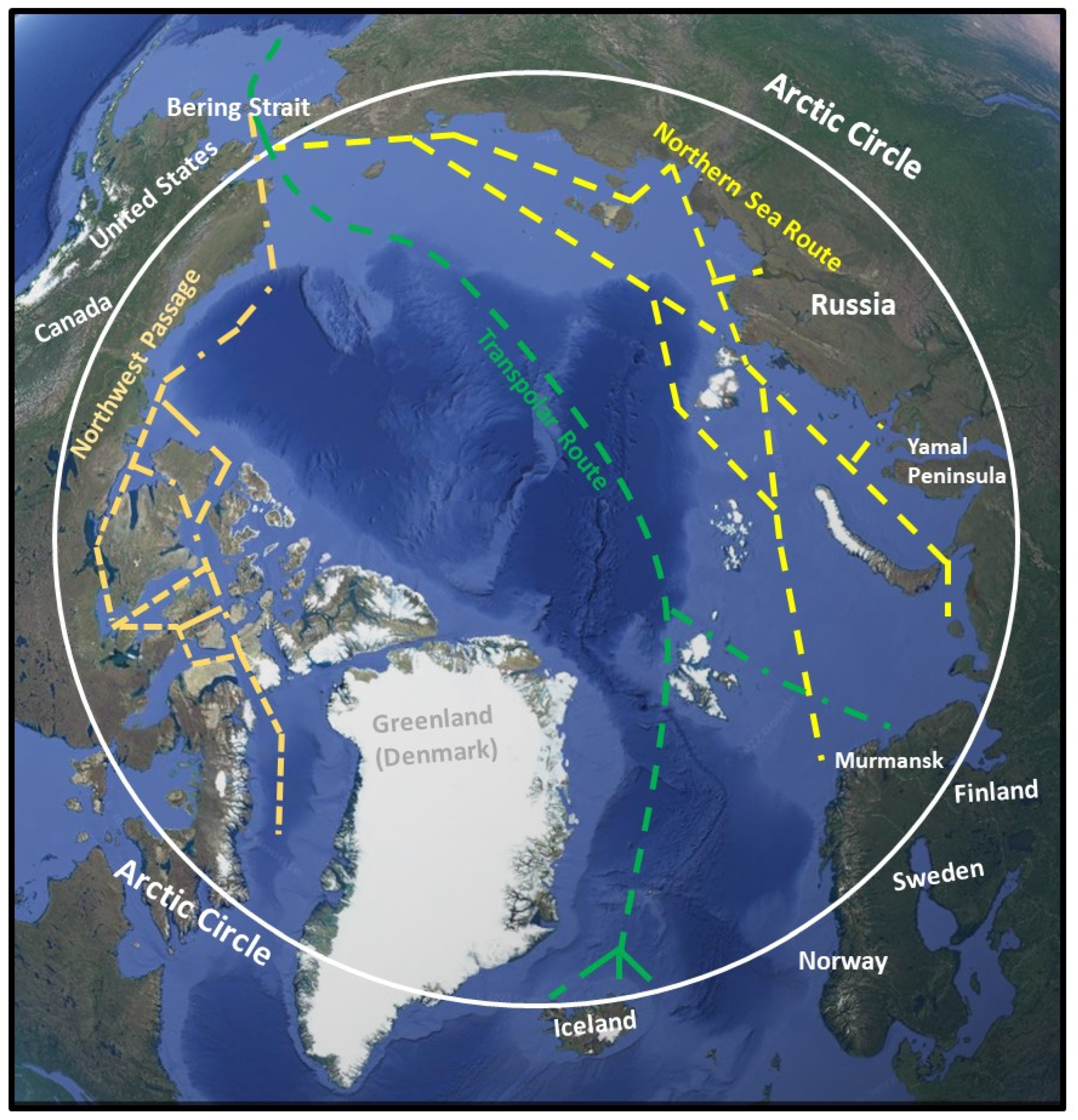

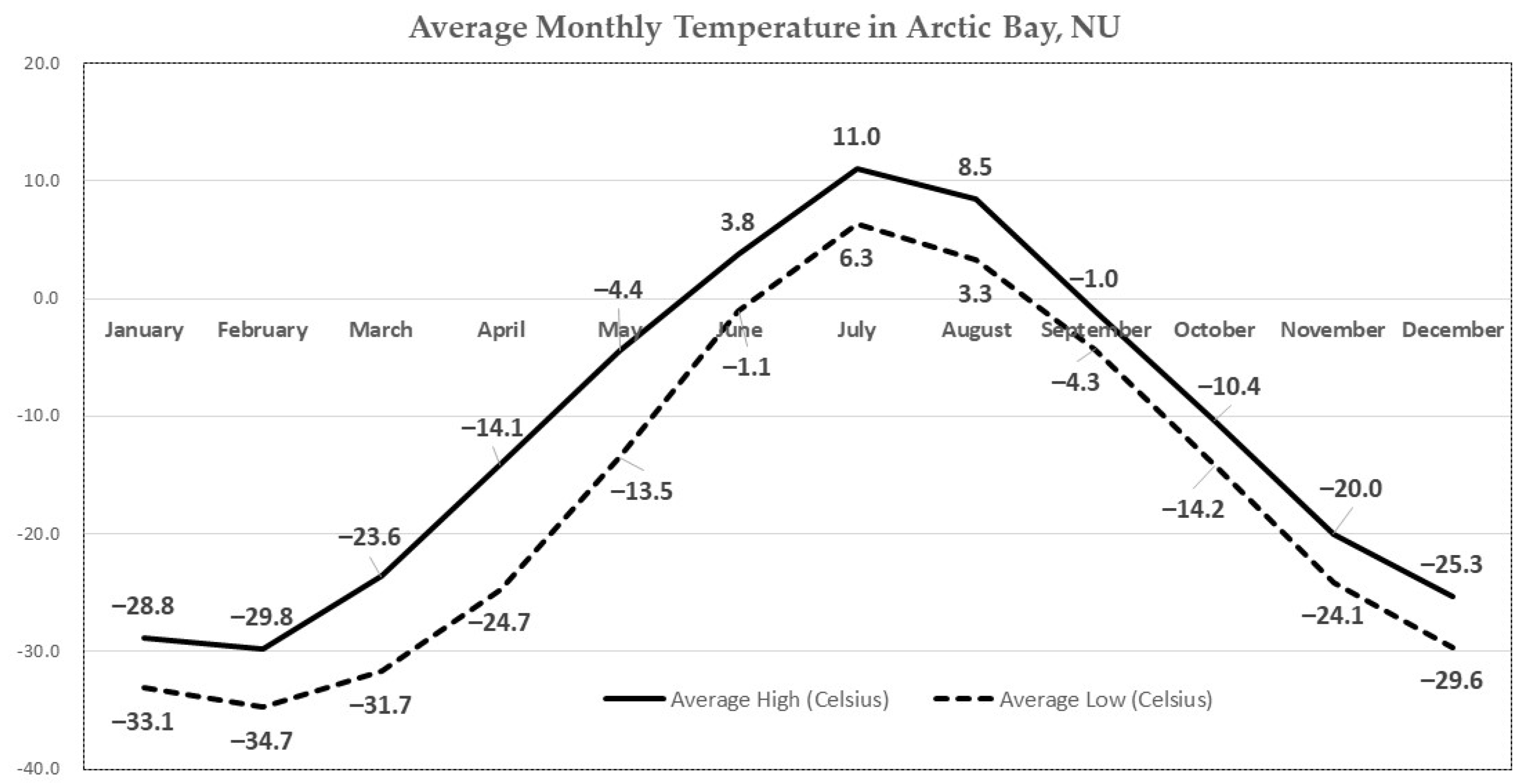
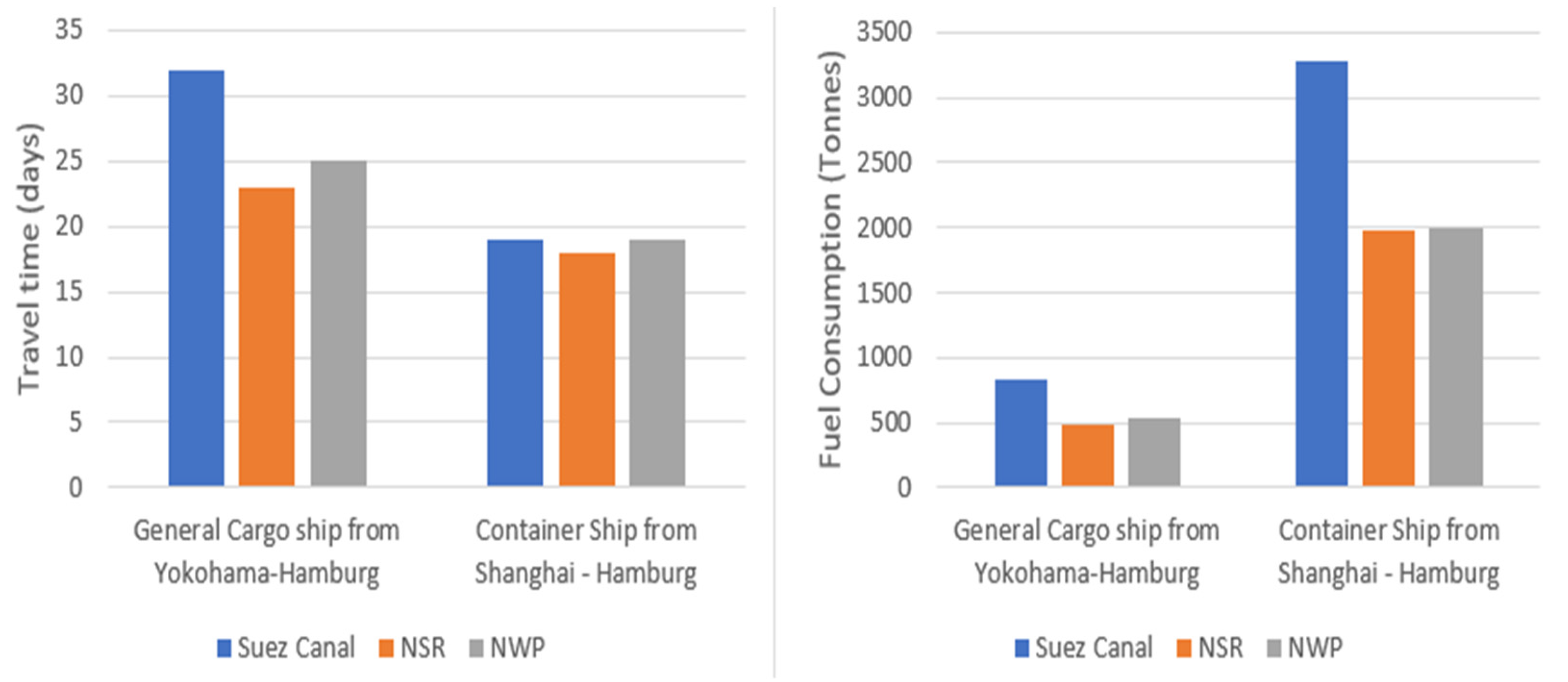
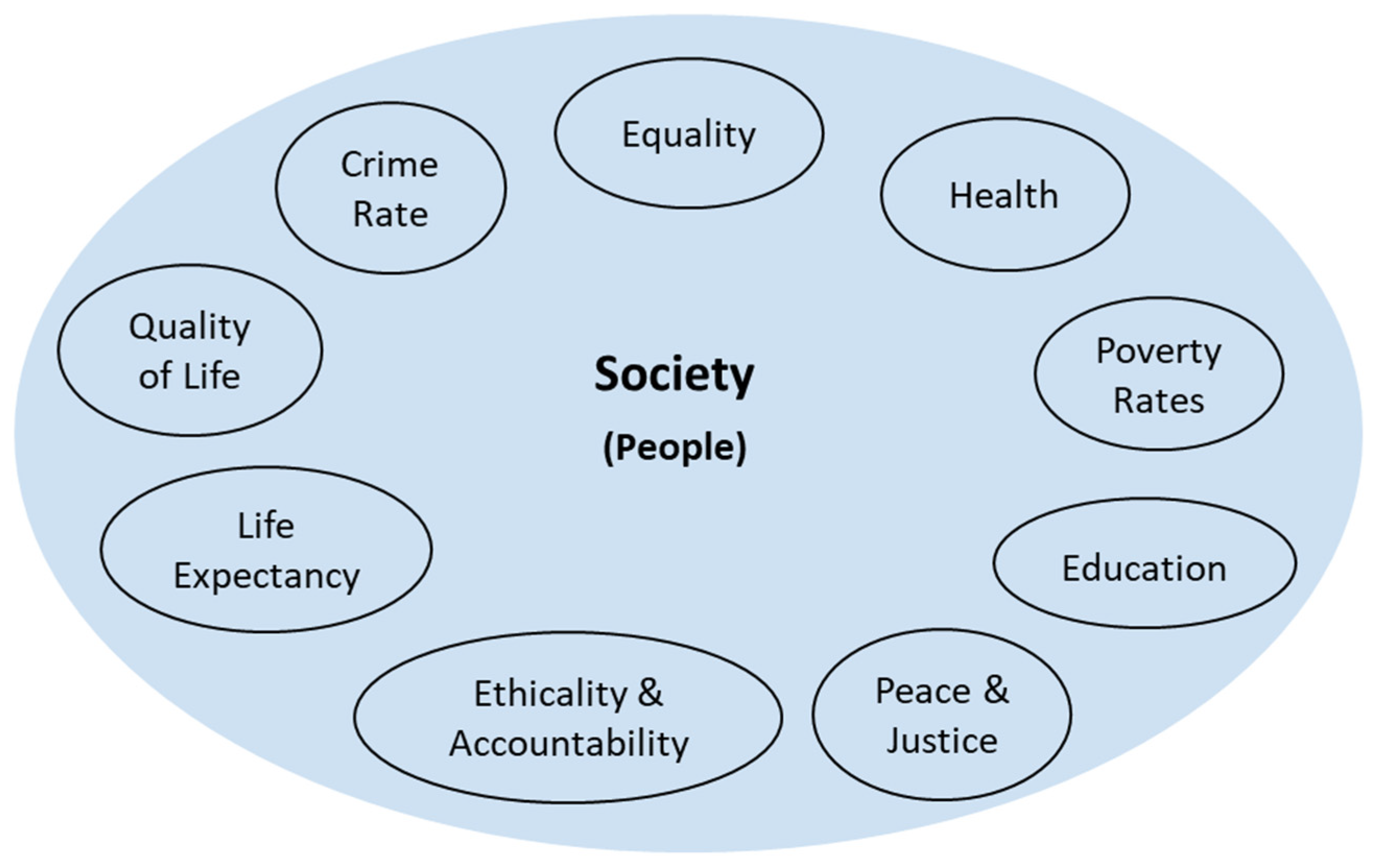

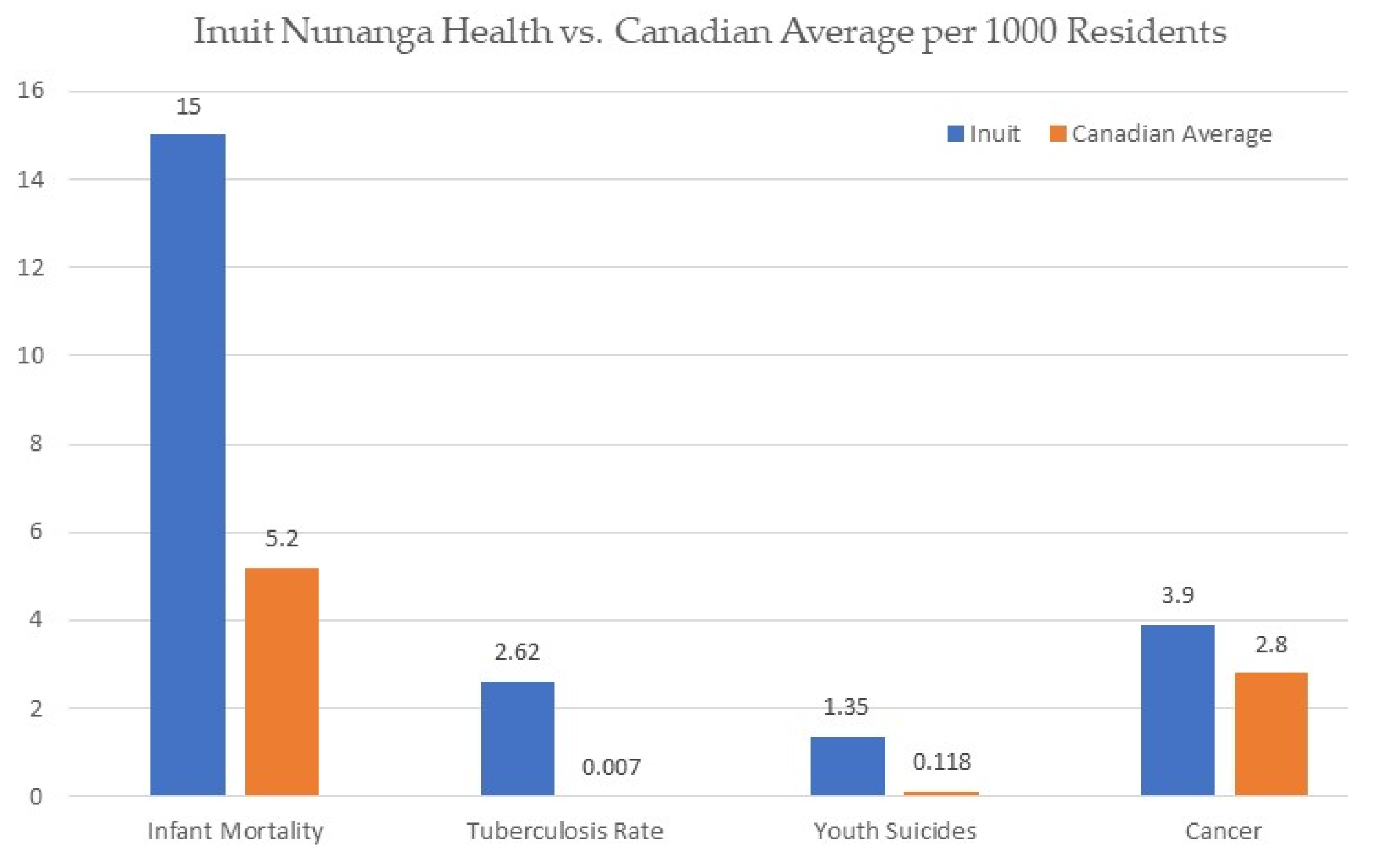

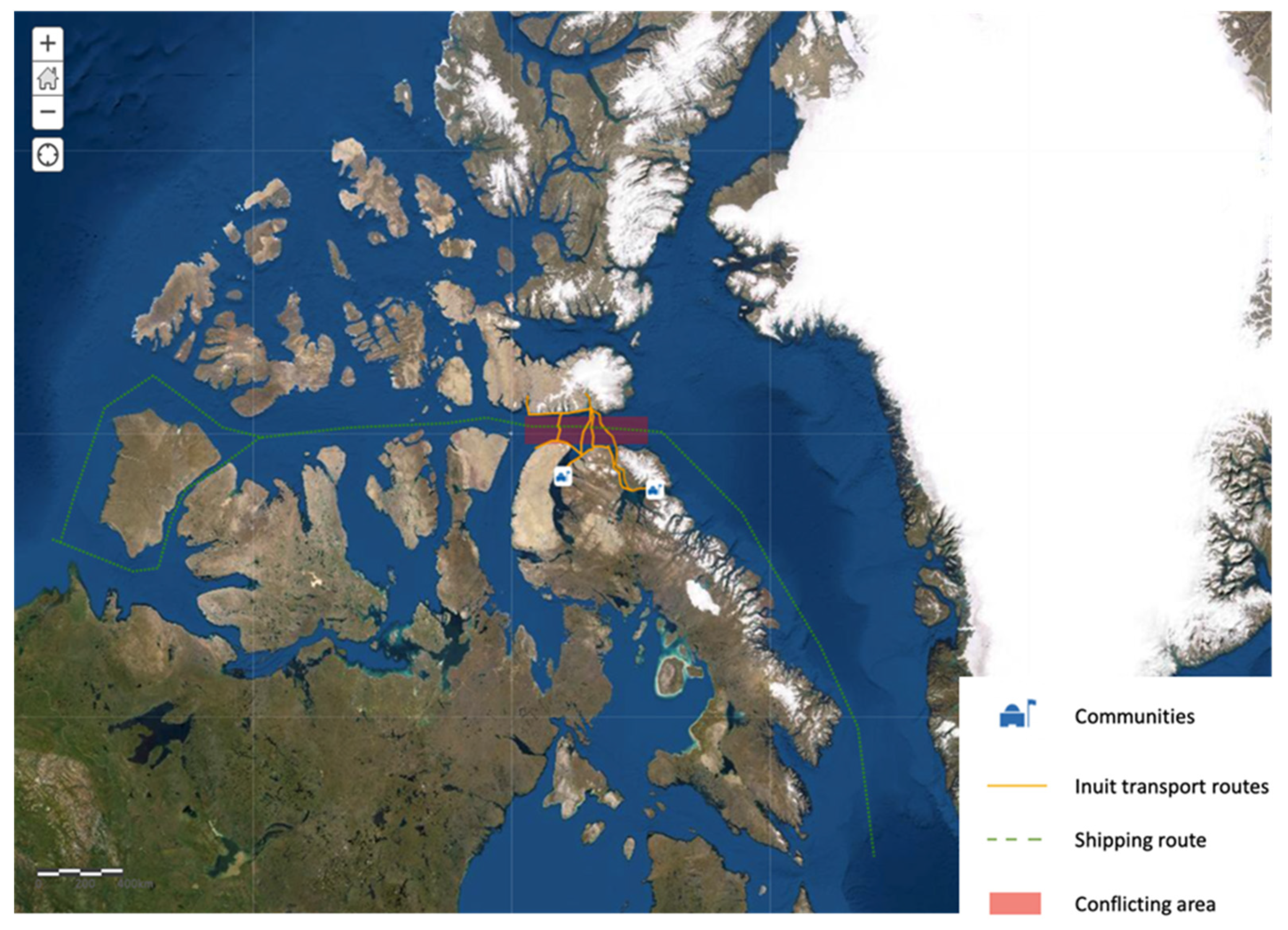
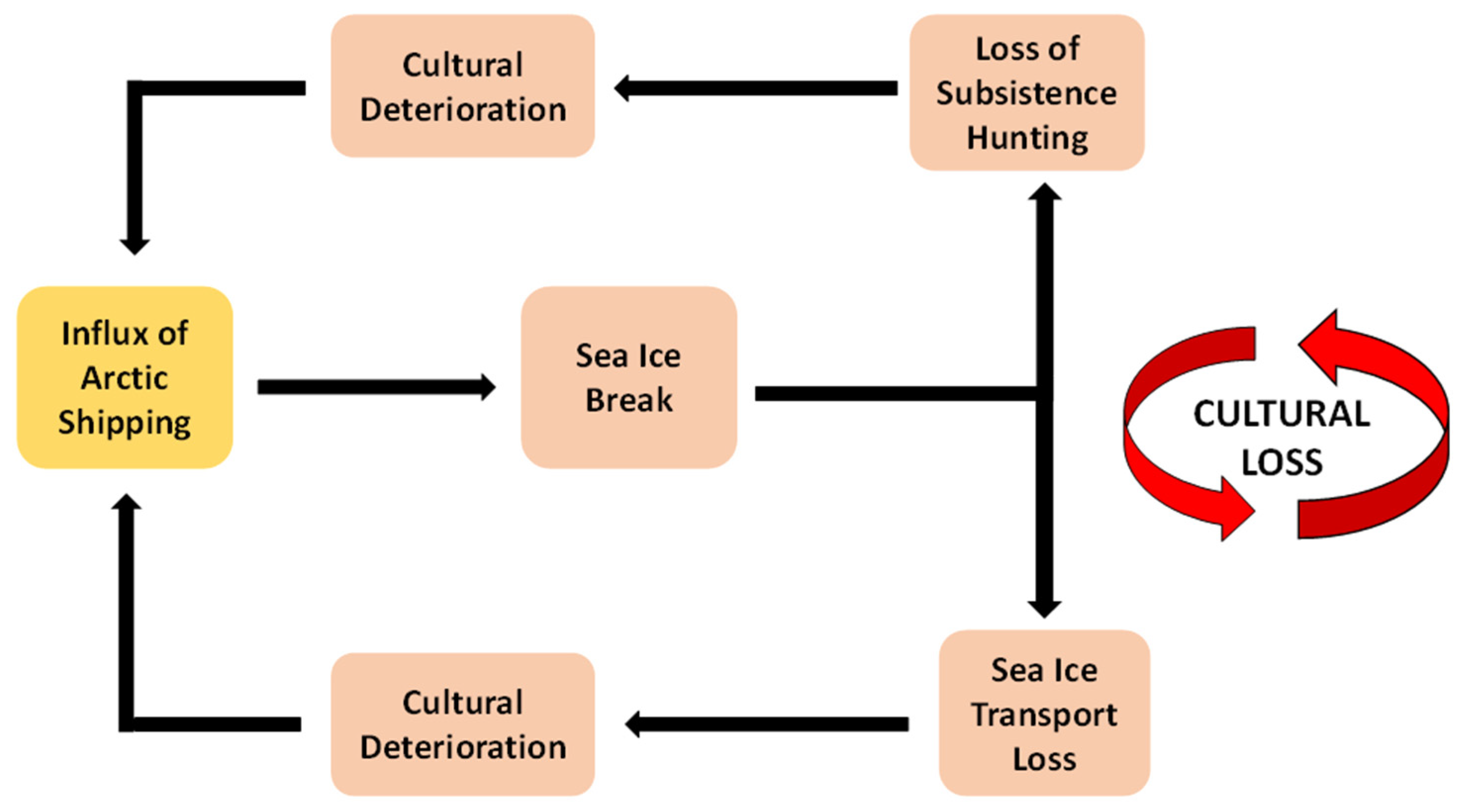

| Papers Compared | QBL Pillars | Approach/Methodology | ||||||
|---|---|---|---|---|---|---|---|---|
| Economy | Environment | Society | Culture | Qualitative | Descriptive | Predictive | Prescriptive | |
| Corbett et al. [13] | ✓ | ✓ | ✓ | |||||
| Smith and Stephenson [14] | ✓ | ✓ | ✓ | |||||
| Buixadé Farré et al. [15] | ✓ | ✓ | ✓ | |||||
| Lu et al. [6] | ✓ | ✓ | ✓ | ✓ | ||||
| Miller and Ruiz [16] | ✓ | ✓ | ✓ | |||||
| Ghosh and Rubly [17] | ✓ | ✓ | ✓ | |||||
| Champalle et al. [18] | ✓ | ✓ | ✓ | |||||
| Halliday et al. [19] | ✓ | ✓ | ✓ | |||||
| Theocharis et al. [20] | ✓ | ✓ | ✓ | |||||
| Ng et al. [21] | ✓ | ✓ | ✓ | ✓ | ✓ | |||
| Downing [22] | ✓ | ✓ | ✓ | |||||
| Our Paper | ✓ | ✓ | ✓ | ✓ | ✓ | ✓ | ✓ | |
| Factors Considered | Potential Effects from ArSh | Related SDGs | |||
|---|---|---|---|---|---|
 |  |  |  | ||
| Employment in the Canadian Arctic | + Higher employment opportunities. + New industries available. | ✓ | ✓ | ✓ | |
| × Traditional forms of employment-hunting and fishing are vulnerable. | |||||
| Cargo shipping through the NWP | + Reduced transport costs for shipping firms who use this shorter route. + Wider area allows large cargo ships. + Greater shelter from storms. | ✓ | ✓ | ||
| × Poor weather conditions could increase product loss & damage. × Cost of preparing for Arctic weather conditions. | |||||
| Economic growth for Canada and the Canadian Arctic | + Opportunity for Canada to charge a toll for users of the NWP. + Improved trade relations with other nations that use the route. + Potential for population growth in Northern Canada. | ✓ | ✓ | ||
| × Natural environment may be damaged, depleting natural resources. | |||||
| Infrastructure update in the Canadian Arctic | + The Arctic will become less remote and more profitable. + Greater access to emergency and safety services in the Arctic. | ✓ | ✓ | ✓ | |
| × Wildlife may be hurt due to a damaged natural environment. | |||||
| Factors Considered | Samples of Hazards | Potential Effects from ArSh | Related SDGs | |||
|---|---|---|---|---|---|---|
 |  |  |  | |||
| Shipping exhaust emissions | Dangerous by-products: SOx, NOx, black carbon, ozone etc. | Acid rain, soot formation, climate-forcing actions etc. | ✓ | ✓ | ✓ | |
| Oil spillage | Accidental discharge of oil from ships | Increased mortality of marine animals, water pollution | ✓ | ✓ | ✓ | ✓ |
| Noise pollution | Ship noise over the acceptable level | Behavioural disturbances in marine mammals | ✓ | |||
| Ship-strikes | Collision of shipping vessels with marine animals | Propeller lacerations, massive trauma, haemorrhage, broken bones or death in marine mammals | ✓ | ✓ | ||
| Use of icebreakers | Open water channels | Trapped marine animals | ✓ | ✓ | ||
| Increased ambient noise | Marine animals’ behavioural disturbance | |||||
| Higher fuel consumption. | Increased carbon emission | |||||
| Factors Considered | Potential Effects from ArSh | Related SDGs | |||||||
|---|---|---|---|---|---|---|---|---|---|
 |  |  |  |  |  |  |  | ||
| Food security in the Canadian Arctic | + More affordable store-bought food. | ✓ | ✓ | ✓ | ✓ | ||||
| × Impact hunting methods. | |||||||||
| Impact on health & well-being of Arctic communities. | + More accessible healthcare | ✓ | ✓ | ✓ | ✓ | ✓ | |||
| × Exacerbated health effects. | |||||||||
| Energy availability and accessibility issues | + More affordable, reliable, and accessible energy. | ✓ | ✓ | ✓ | ✓ | ✓ | ✓ | ||
| Inclusion and criminal safety in the Arctic communities | + More inclusive society for Northern communities + Higher safety | ✓ | ✓ | ✓ | ✓ | ||||
| × Increased traffic and criminal behaviour | |||||||||
| Peaceful Industry and Interaction in Arctic communities | +× Peaceful cooperation or conflicting disputes (case dependent) | ✓ | ✓ | ✓ | ✓ | ||||
| Factors Considered | Potential Effects from Arctic Shipping | Related SDGs | |||
|---|---|---|---|---|---|
 |  |  |  | ||
| Noise pollution from ships | × Impacts Inuit traditional hunting methods culturally significant for Arctic communities. | ✓ | ✓ | ✓ | |
| Ship-sourced sea ice deterioration | × Breaks sea ice that Inuit use for transport, hunting, spiritual significance, & way of life. | ✓ | ✓ | ||
| The feedback loop of cultural loss | × Possible ongoing positive feedback loop of how increased shipping will cause more cultural loss, and then continue the cycle. | ✓ | ✓ | ||
| Cultural assimilation | × Immigration and population growth to Arctic communities (due to employment opportunities brought by shipping) could result in cultural assimilation. | ✓ | ✓ | ✓ | |
| Increased knowledge of Inuit leading to cultural preservation | + More immigration to Arctic communities could result in more knowledge of the Inuit people. Thus, more effort could be made to preserve their culture. | ✓ | ✓ | ||
Publisher’s Note: MDPI stays neutral with regard to jurisdictional claims in published maps and institutional affiliations. |
© 2022 by the authors. Licensee MDPI, Basel, Switzerland. This article is an open access article distributed under the terms and conditions of the Creative Commons Attribution (CC BY) license (https://creativecommons.org/licenses/by/4.0/).
Share and Cite
Tiller, S.J.; Rhindress, A.P.; Oguntola, I.O.; Ülkü, M.A.; Williams, K.A.; Sundararajan, B. Exploring the Impact of Climate Change on Arctic Shipping through the Lenses of Quadruple Bottom Line and Sustainable Development Goals. Sustainability 2022, 14, 2193. https://doi.org/10.3390/su14042193
Tiller SJ, Rhindress AP, Oguntola IO, Ülkü MA, Williams KA, Sundararajan B. Exploring the Impact of Climate Change on Arctic Shipping through the Lenses of Quadruple Bottom Line and Sustainable Development Goals. Sustainability. 2022; 14(4):2193. https://doi.org/10.3390/su14042193
Chicago/Turabian StyleTiller, Stephen J., Adam P. Rhindress, Ibrahim O. Oguntola, M. Ali Ülkü, Kent A. Williams, and Binod Sundararajan. 2022. "Exploring the Impact of Climate Change on Arctic Shipping through the Lenses of Quadruple Bottom Line and Sustainable Development Goals" Sustainability 14, no. 4: 2193. https://doi.org/10.3390/su14042193
APA StyleTiller, S. J., Rhindress, A. P., Oguntola, I. O., Ülkü, M. A., Williams, K. A., & Sundararajan, B. (2022). Exploring the Impact of Climate Change on Arctic Shipping through the Lenses of Quadruple Bottom Line and Sustainable Development Goals. Sustainability, 14(4), 2193. https://doi.org/10.3390/su14042193








